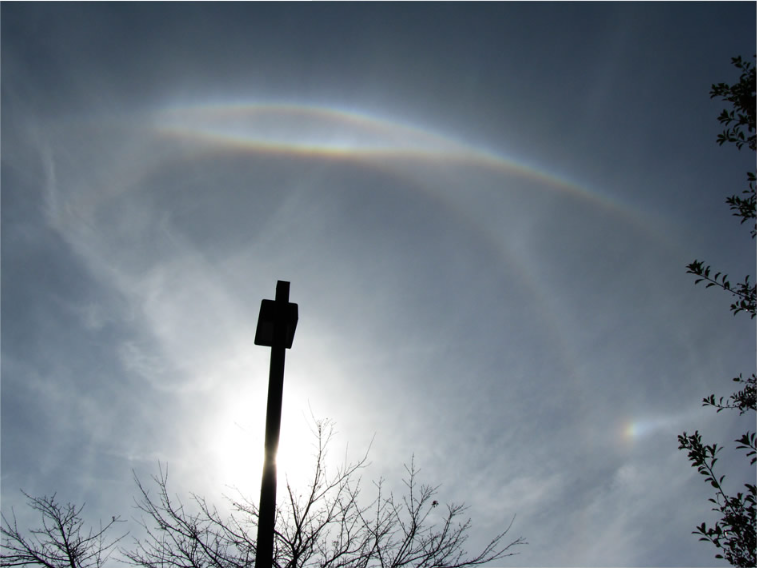OPOD - Georgia USA Halos
OPOD - Georgia USA Halos: A Mesmerizing Display of Atmospheric Optics
Have you ever witnessed a mesmerizing display of atmospheric optics? On December 5, 2008, Tom Faber captured a magnificent high cloud halo display near Alpharetta, Georgia. This captivating phenomenon showcased a variety of halos, both bright and faint, created by the interaction of sunlight with ice crystals suspended in the atmosphere.
Let's dive deeper into the intricacies of these captivating halos and explore the science behind their formation.
Bright Halos: A Play of Light and Ice Crystals
At the top of the circular 22° radius halo, we observe an intense and sharp arc that curves towards the sun. This phenomenon is known as an upper tangent arc or a circumscribed halo. As the sun's elevation exceeds 29 degrees, the name of this arc changes. It is produced by sunlight passing through column-shaped ice crystals with their long axis oriented horizontally.
Adjacent to the upper tangent arc, we encounter another remarkable halo - the suncave Parry arc. Although rarer, this arc exhibits a similar brightness to its neighboring tangent arc. The Parry arc is formed by sunlight interacting with six-sided ice crystals that possess two prism side faces positioned horizontally. The distinct crystal orientation of the Parry arc crystals gives rise to its unique appearance.
Adding to the spectacle, we find a prismatic sundog on the right side of the image. This sundog is produced by plate-shaped ice crystals, which diffract sunlight and create a colorful display.
Fainter and Rarer Halos: Unveiling Hidden Gems
Beyond the bright halos lie fainter and rarer atmospheric phenomena that demand our attention. An upper Lowitz arc extends from the 22° halo, passes through the tangent arc, and ultimately becomes tangent to the upper Parry arc. Tobias Lowitz, an 18th-century scientist, first described this family of arcs in 1790, but it wasn't until recent years that they were captured on camera. The Lowitz arc adds an ethereal touch to the already captivating halo display.
As if the Lowitz arc wasn't enough to leave us in awe, we encounter an even more elusive phenomenon - the helic arc. This rare halo is formed by sunlight reflecting off the side faces of Parry-oriented ice crystals. The helic arc extends upwards from the sun, intersecting the 22° halo and the upper tangent arc. Its graceful spiral shape adds a touch of mystique to the atmospheric optics spectacle.
Conclusion: Nature's Artistry Unveiled
The captivating halo display captured by Tom Faber near Alpharetta, Georgia, offers a glimpse into the breathtaking world of atmospheric optics. The interplay between sunlight and ice crystals creates a symphony of halos, each with its unique characteristics and formation mechanisms.
As we marvel at these natural wonders, let us appreciate the delicate balance of scientific principles and artistic beauty that coexist in our atmosphere. The next time you find yourself gazing at the sky, take a moment to search for these hidden gems and immerse yourself in the captivating world of atmospheric optics.

Ice Halos, Georgia USA
An image by Tom Faber of the magnificent high cloud halo display near Alpharetta, Georgia on Dec 5, '08.
©Tom Faber, shown with permission.
First the bright halos:
Touching the top of the circular 22° radius halo is an intense and sharp arc convex to the sun. This is an upper tangent arc or, strictly speaking a circumscribed halo because the sun is just higher than the 29 degrees its name changes.
Above that is a rarer arc but here almost equally bright – a suncave Parry arc.
Both arcs are produced by similar ray paths through six sided, column shaped ice crystals drifting with their long axis oriented nearly horizontally. Those making the tangent arc have all rotational positions about the long axis. Those making the Parry arcs do not rotate but are instead most improbably oriented with two prism side faces horizontal. The different crystal orientations dramatically change the halo produced.
Another ice crystal habit, plates, made the prismatic sundog at right.
Now the fainter and much rarer halos:
An upper Lowitz arc stretches from the 22° halo, through the tangent arc to itself become tangent to the upper Parry arc. Tobias Lowitz first drew one of the family of these arcs in 1790 at St Petersburg but they were not photographed until a few years ago.
If a long sought Lowitz arc was not enough, an even rarer helic arc produced by reflection from the side faces of the Parry oriented crystals extends up from the sun, crossing the 22 degree and upper tangent arcs.

Note: this article has been automatically converted from the old site and may not appear as intended. You can find the original article here.
Reference Atmospheric Optics
If you use any of the definitions, information, or data presented on Atmospheric Optics, please copy the link or reference below to properly credit us as the reference source. Thank you!
-
<a href="https://atoptics.co.uk/blog/opod-georgia-usa-halos/">OPOD - Georgia USA Halos</a>
-
"OPOD - Georgia USA Halos". Atmospheric Optics. Accessed on November 21, 2024. https://atoptics.co.uk/blog/opod-georgia-usa-halos/.
-
"OPOD - Georgia USA Halos". Atmospheric Optics, https://atoptics.co.uk/blog/opod-georgia-usa-halos/. Accessed 21 November, 2024
-
OPOD - Georgia USA Halos. Atmospheric Optics. Retrieved from https://atoptics.co.uk/blog/opod-georgia-usa-halos/.